Monuments and Ornaments at Wrest Park
The gardens of Wrest Park contain a number of single ornaments and groups of ornaments. The following are listed in rough date order.

Part of the group of five Roman altars September 2011
Five Graeco-Roman Altars
This group of five altars stands eighty yards or so south of Ladies' Lake. They are original and so by far the oldest things in the garden. One altar stands in the centre with the other four around it.
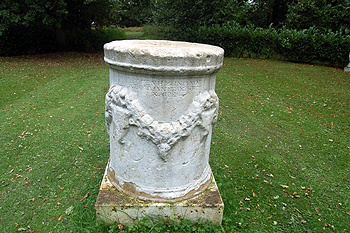
Central of a group of five Roman altars September 2011
They were purchased by Amabell, Countess de Grey in 1817 [CRT130Silsoe4]. All are marble and cylindrical standing about four feet high on square plinths. They are, as one would expect, very worn.

Inscription on the central of five Roman altars September 2011
The central altar has an inscription in Greek characters. This is much less worn than the rest of the alter and so is, no doubt, a conceit of the early 19th century.
Monuments to the Earl of Harrold and Lady Glenorchy

Memorial to the Earl of Harrold September 2011
These two monuments stand close to one another, about two hundred yards south of LadiesLake. They were both children of the Duke of Kent. The Earl of Harrold died in 1723, aged 27 and Amabell, Lady Glenorchy died of cancer in 1727. Her daughter Jemima, Marchioness Grey succeeded to Wrest Park.
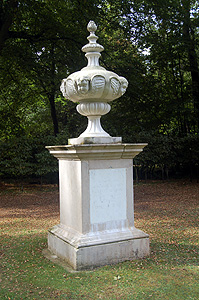
Memorial to Lady Glenorchy September 2011
Both monuments are in the form of an urn on a pediment. Both urns are 20th century reproductions. One memorial reads: "To the memory of Anthony de Grey, Earl of Harrold, Baron Lucas of Crudwell, Lord of the Bedchamber to King George the 1st, eldest son of Henry, Duke of Kent". The other reads: "To the memory of Amabel de Grey, lady Glenorchy, eldest daughter of Henry Duke of Kent".
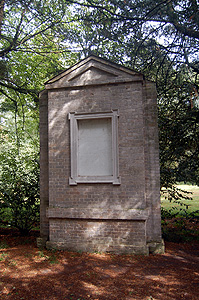
Memorial to Thomas Hutton September 2011
Monument to Thomas Hutton
The monument stands a hundred and seventy five yards south of the West Half House and was erected about 1730 for the Duke of Kent. It is in the form of a brick wall with an inset ashlar plaque. The rather condescending inscription reads: "To the memory of Thomas Hutton Esq. of Somerset House, who often took great delight in this place and whose company was always useful and agreeable to his friend, Henry Duke of Kent".
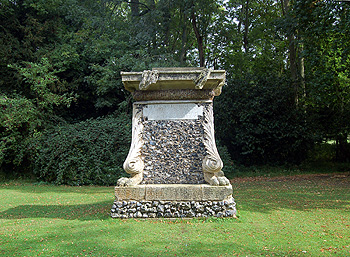
Mithraic Altar September 2011
The Mithraic Altar
Mithras was an ancient Persian god who became the focus of a mystery religion popular in the Roman Empire, particularly among soldiers. This altar is not an original example but a fanciful creation of 1748 for the Marchioness Grey.

Inscription on the Mithraic Altar September 2011
It is rectangular and about ten feet high. The lower part of the base is made of large flints the upper part is ashlar. The main part of the altar is of smaller flints. It carries an inscription in old Greek.
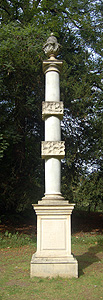
The memorial to Capability Brown September 2011
Monument to Capability Brown
This stands at the west end of Broad Water. It is a Doric column about twenty feet high, cut by two rough cut blocks and surmounted by, of all things, a pineapple. It stands on a rectangular plinth. A similar monument, but without the two rough cut blocks appears in a painting by Peter Tillemans of about 1729 [L33/133] so the current monument may be a reworking of this.
![Doric column painted by Tillemans about 1729 [L33/133]](/CommunityHistories/Silsoe/SilsoeImages/Doric column painted by Tillemans about 1729 [L33-.jpg)
Doric column painted by Tillemans about 1729 [L33/133]
The text reads: These gardens originally laid out by Henry, Duke of Kent, were altered by Philip, Earl of Hardwicke and Jemima, Marchioness Grey, with the professional assistance of Lancelot Brown, Esquire in the years 1758, 1759, 1760".
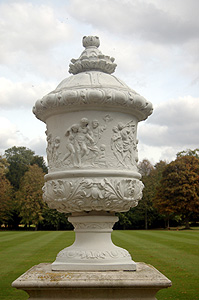
An urn at the Bowling Green House September 2011
Urns
There are a number of these in the grounds and four 18th century examples, in two pairs, have been listed. These are:
- an urn five yards north-east of the Bowling Green House, this is by John Nost (died 1729), a Flemish sculptor who moved to England at the end of the 17th century, or his nephew who carried on the business but moved to Dublin about 1750;
- an urn five yards south-east of the Bowling Green House also by Nost.
- an urn ten yards south-east of The Orangery, which was party restored in the 20th century;
- an urn ten yards north-east of the Orangery, again partly restored in the 20th century
A Coade Stone Plinth
This dates to about 1800 and lies forty yards or so south of the West Half House. It has been repositioned from somewhere else in the garden. It stands five feet high and is rectangular with classical scenes on each side. It also has a frieze of rams' heads at the corners and husk garlands on each side. It originally had yet another urn on it but only the base and pedestal of this remain.
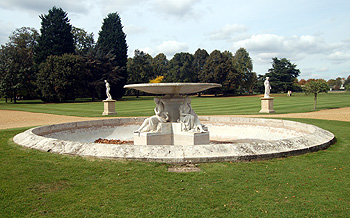
The Fountain September 2011
The Fountain
About two hundred yards of the mansion is a fountain. It is surrounded by eight statues and lies at the centre of two walks around the grounds. The fountain itself stands in a small circular pond about thirty five yards in diameter. It was probably built about 1840 for the 2nd Earl de Grey. The base of the fountain and the pond wall are ashlar. The fountain itself is marble and is ten feet or so in diameter standing about four feet high on a pedestal which is surrounded by four seated female figures in classical dress: one has an oar; one has a dolphin and one a bird.
![The sundial in 1917 [AD3237]](/CommunityHistories/Silsoe/SilsoeImages/The sundial in 1917 [AD3237].jpg)
The sundial in 1917 [AD3237]
The Sundial
Like the fountain this was probably made for the 2nd Earl de Grey. It is also surrounded by statues. The sundial is made of marble and stands about three feet high. It is octagonal with a foliage decoration on the pedestal base and underneath the top. The upper part has representations of festoons of flowers and ribbons. At the time of writing [2011] the sundial lacks its brass gnomon.

The sundial September 2011
The Mermaid Basin
This stands on the west side of the south parterre. It dates from the mid 19th century and was probably erected by the 2nd Earl de Grey. It stands on a low stone base and is about four feet high. It has four seated mermaids each with her right arm outstretched and originally supported a broad basin, which has now been replaced by a small one.